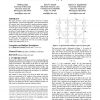Free Online Productivity Tools
i2Speak
i2Symbol
i2OCR
iTex2Img
iWeb2Print
iWeb2Shot
i2Type
iPdf2Split
iPdf2Merge
i2Bopomofo
i2Arabic
i2Style
i2Image
i2PDF
iLatex2Rtf
Sci2ools
DAC
2003
ACM
2003
ACM
Random walks in a supply network
This paper presents a power grid analyzer based on a random walk technique. A linear-time algorithm is first demonstrated for DC analysis, and is then extended to perform transient analysis. The method has the desirable property of localizing computation, so that it shows massive benefits over conventional methods when only a small part of the grid is to be analyzed (for example, when the effects of small changes to the grid are to be examined). Even for the full analysis of the grid, experimental results show that the method is faster than existing approaches and has an acceptable error margin. This method has been applied to test circuits of up to 2.3M nodes. For example, for a circuit with 70K nodes, the solution time for a single node was 0.42 sec and the complete solution was obtained in 17.6 sec. Categories and Subject Descriptors B.7.2 [Integrated Circuits]: Design Aids ? simulation. General Terms Algorithms, Reliability, Verification. Keywords Random walk, power grid.
Acceptable Error Margin | DAC 2003 | Design Automation | Power Grid Analyzer | Random Walk Technique |
| Added | 13 Nov 2009 |
| Updated | 13 Nov 2009 |
| Type | Conference |
| Year | 2003 |
| Where | DAC |
| Authors | Haifeng Qian, Sani R. Nassif, Sachin S. Sapatnekar |
Comments (0)

